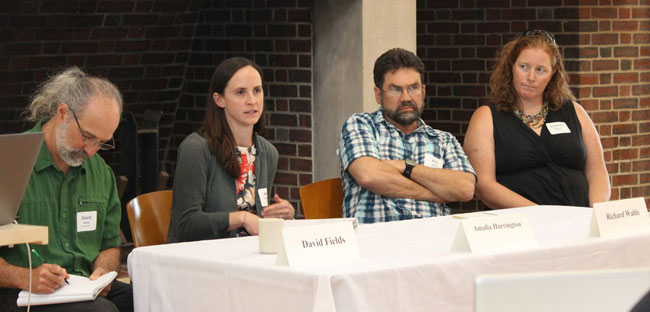What Science Knows About Ocean Acidification and Maine’s Lobsters

Left to right: David Fields, Amalia Harrington, Richard Wahle and Kathleen Reardon. “We’re finding interactive effects between acidification and warming that other people have missed by looking at them separately.” – David Fields. Fishermen’s Voice photo.
JUNE 12, BRUNSWICK—A group of about fifty people met here today to hear four scientists discuss new research on the effects of rising ocean acidity and ocean temperatures on inshore habitat and marine life. The program, sponsored by Bowdoin College, Friends of Casco Bay and the University of Maine, featured scientists David Fields, Amalia Harrington, Richard Wahle and Kathleen Reardon. The scientists discussed research on how acidity and water temperature are affecting larval lobster. Changing weather patterns are also putting more fresh water into the Gulf of Maine and making surface water less saline and this is where lobster larvae live.
Maine Ocean & Coastal Acidification Partnership is an all-volunteer coalition working to understand and address the growing threat of acidification before it irrevocably harms Maine’s iconic fisheries. Their spokesperson said they were using the day to launch a Citizen Science effort. Volunteers in communities along the Maine coast will take water samples and record other information on inshore waters.
Scientists, fishermen,
and state officials are
concerned about lobster
in particular because
the species is so
economically and
culturally important.
Bigelow Laboratory for Ocean Sciences Senior Research Scientist David Fields is studying several crustaceans in their planktonic stages to learn how climate change effects like ocean acidification and rising temperatures will shape their future. Larvae were hatched at the Darling Marine Center from egg-bearing females from different locations. Newly hatched larvae from Rhode Island and Downeast Maine were put in ambient water (16C) as well as water heated to 19C, the temperature that represents the predicted average Gulf of Maine temperature in the year 2100. The water was also acidified to see the response of larvae to the predicted levels of ocean acidification.
Changing ocean conditions simulated in the lab diminish the quality of the copepods that larvae consume. These copepods do not store as much fat. As a result the lobster larvae’s physical characteristics change. The lobster’s carapace length is greater in colder water. The researchers found that some lobsters in the warmer waters of Rhode Island had the same length carapace as Downeast Maine lobster, but the Rhode Island lobsters had skinnier bodies.
“We’re finding interactive effects between acidification and warming that other people have missed by looking at them separately,” Fields said. He and his colleagues study the physiological and environmental influences on the regional and global scale distribution of zooplankton, including larval lobsters and essential elements of the Gulf of Maine ecosystem such as copepods.
“As the ocean warms, the water conditions favorable to lobsters are steadily retreating up the coast,” Fields said. “We think that the current Rhode Island population gives us a way to look at the future of Maine’s Downeast population, and the current Downeast population is likely representative of a future Canadian population.”
Wahle founded a U.S.-Canada monitoring collaborative and database of nursery grounds of the American lobster, with the aim of developing predictive tools for trends in the fishery. Wahle said this longstanding annual lobster settlement survey shows there are fewer juvenile lobsters settling on the ocean bottom. This raises concern among both scientists and harvesters about how the fishery may be impacted in several years, when the lobsters reach market size. “We need comparative studies in the lab to assess larvae responses to changes in a controlled environment,” said Wahle.
Scientists, fishermen, and state officials are concerned about lobster in particular because the species is so economically and culturally important. In recent years, there has been an overall upward trend of lobster landings in the northern part of the lobsters’ range, while in the southern part of the range, landings have trended downward. Reardon said the Maine Department of Marine Resources has moved to increase research on ocean acidity. Reardon is going out on boats to collect information on the late stages of lobster development.
